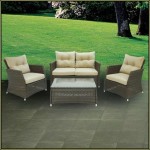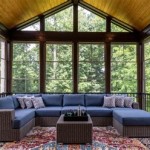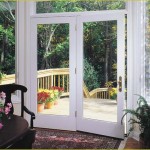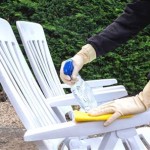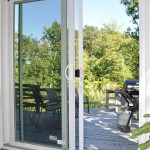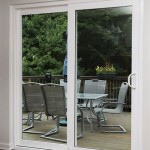Patio Wicker Set: A Comprehensive Guide
Patio wicker sets are a popular choice for outdoor furniture, offering a blend of aesthetic appeal, durability, and comfort. The term "wicker" broadly refers to the weaving process rather than a specific material. Consequently, patio wicker sets can be constructed from various materials, each with its own set of advantages and disadvantages. Understanding the different types of wicker, construction quality, and maintenance requirements is crucial for selecting a patio wicker set that meets specific needs and preferences.
The purpose of this guide is to provide a comprehensive overview of patio wicker sets, covering material types, construction methods, comfort considerations, and essential maintenance practices. By understanding these aspects, individuals can make informed decisions when investing in patio wicker furniture, ensuring long-term satisfaction and enjoyment of their outdoor space.
Material Types Used in Patio Wicker Sets
The material used to create patio wicker significantly impacts its appearance, durability, and weather resistance. The primary materials employed in wicker construction are natural wicker and synthetic wicker, each offering distinct characteristics.
Natural Wicker: Historically, wicker furniture was crafted from natural materials such as rattan, bamboo, reed, and willow. These materials contribute a rustic and charming aesthetic to the furniture. Rattan, derived from various climbing palm species, is particularly prized for its strength and flexibility, making it ideal for intricate weaving patterns. Bamboo provides a lightweight yet sturdy option, while reed and willow offer a more delicate and traditional appearance. However, natural wicker is susceptible to damage from moisture, sunlight, and temperature fluctuations. Exposure to these elements can lead to cracking, fading, and eventual deterioration. Therefore, natural wicker furniture is best suited for covered patios or porches where it is protected from the elements. Regular sealing and weatherproofing treatments are necessary to prolong the lifespan of natural wicker furniture.
Synthetic Wicker: Also known as resin wicker or all-weather wicker, synthetic wicker is typically made from polyethylene (PE), polypropylene (PP), or polyvinyl chloride (PVC). These synthetic materials are designed to mimic the appearance of natural wicker while offering significantly enhanced durability and weather resistance. Synthetic wicker is resistant to fading, cracking, and moisture damage, making it suitable for outdoor use in a variety of climates. PE wicker is often considered the highest quality synthetic option due to its superior UV resistance and flexibility. PP wicker is a more economical choice, while PVC wicker is generally less durable and may become brittle over time. An important consideration is the recyclability of the synthetic material. While some synthetic wickers are recyclable, others are not. Environmentally conscious consumers may prioritize options made from recycled materials or those that can be recycled at the end of their lifespan.
Beyond the wicker material itself, the frame supporting the wicker is also a critical consideration. Aluminum frames are lightweight, rust-resistant, and durable, making them an excellent choice for outdoor furniture. Steel frames are stronger than aluminum but are susceptible to rust if not properly coated. Wood frames offer a classic aesthetic but require regular maintenance to prevent rot and decay.
Construction Quality and Considerations
The construction quality of a patio wicker set is a major determinant of its longevity and structural integrity. Factors such as the weaving technique, frame construction, and hardware used all contribute to the overall quality of the furniture.
Weaving Technique: The tightness and consistency of the weave are important indicators of quality. A tightly woven wicker set is more durable and less likely to unravel than a loosely woven one. The weaving pattern can vary, from simple over-and-under weaves to more intricate designs. Complex patterns often indicate a higher level of craftsmanship, but they may also require more specialized maintenance. Look for even spacing and uniform tension throughout the weave. Irregularities in the weave can indicate poor workmanship and may lead to structural weaknesses.
Frame Construction: As noted previously, the frame provides the structural support for the wicker. Welded aluminum frames are generally considered the most durable option, providing a strong and rust-resistant foundation. Steel frames should be powder-coated to prevent rust, and wood frames should be constructed from weather-resistant species such as teak or cedar. The joints in the frame should be securely fastened with screws or bolts, rather than glue alone. Inspect the frame for any signs of damage or weakness before purchasing the furniture.
Hardware and Fasteners: The hardware used to assemble the patio wicker set should also be of high quality. Stainless steel screws and bolts are resistant to rust and corrosion, ensuring a secure and long-lasting connection. Look for fasteners that are recessed or covered to prevent snagging on clothing or skin. The cushions should be securely attached to the frame with straps or ties to prevent them from sliding around. Zippers on cushion covers should be durable and easy to operate.
In addition to these construction details, consider the overall weight capacity of the furniture. Ensure that the chairs and sofas are capable of supporting the weight of the intended users. Overloading the furniture can lead to premature wear and tear and may even cause structural failure.
Comfort and Ergonomics of Patio Wicker Sets
While durability and aesthetics are important, comfort is a crucial consideration when choosing patio wicker furniture. The design of the furniture, the quality of the cushions, and the overall ergonomics all contribute to the user's comfort and enjoyment.
Furniture Design: The shape and size of the furniture should be appropriate for the intended use. Deep seating options with generous cushions are ideal for lounging and relaxation, while smaller chairs and tables are suitable for dining or casual conversation. Consider the height of the seats and the angle of the backrests to ensure proper support and comfort. Some wicker sets include features such as adjustable backrests or footrests, allowing users to customize their seating position. Armrests should be wide and comfortable, providing adequate support for the arms and shoulders.
Cushion Quality: The cushions are a critical component of patio wicker sets, providing padding and support. Look for cushions made from high-density foam that will retain its shape and provide adequate cushioning over time. The fabric used to cover the cushions should be durable, weather-resistant, and fade-resistant. Common fabric options include olefin, acrylic, and polyester. Olefin is a synthetic fiber that is resistant to stains, mildew, and fading. Acrylic fabrics, such as Sunbrella, are known for their exceptional UV resistance and durability. Polyester is a more economical option, but it may not be as resistant to fading as olefin or acrylic. The cushion covers should be removable and washable for easy cleaning.
Ergonomics: Ergonomics refers to the design of the furniture to fit the human body. A well-designed patio wicker set will provide adequate support for the back, legs, and arms, reducing strain and fatigue. Consider the height of the seats in relation to the tables. The seat height should allow for comfortable dining or conversation without straining the neck or back. The angle of the backrests should provide adequate lumbar support. Look for chairs and sofas with curved backrests that conform to the natural curve of the spine. If possible, test the furniture before purchasing it to ensure that it is comfortable and supportive.
Beyond the furniture itself, consider the surrounding environment. Shade can significantly enhance the comfort of an outdoor space. Consider adding a patio umbrella or pergola to provide protection from the sun. Outdoor rugs can add warmth and comfort underfoot. Potted plants can create a relaxing and inviting atmosphere. By paying attention to both the furniture and the surrounding environment, it is possible to create a comfortable and enjoyable outdoor space.
Maintenance and Care of Patio Wicker Sets
Proper maintenance is essential for prolonging the lifespan of patio wicker sets. Regular cleaning and care can prevent damage from the elements and keep the furniture looking its best.
Regular Cleaning: The frequency of cleaning will depend on the environment and the amount of use the furniture receives. In general, patio wicker sets should be cleaned at least once a month. Use a soft brush or cloth and a mild soap solution to remove dirt, dust, and debris. Avoid using harsh chemicals or abrasive cleaners, as these can damage the wicker and the frame. Rinse the furniture thoroughly with water after cleaning. For stubborn stains, consider using a specialized wicker cleaner.
Weather Protection: Even synthetic wicker is subject to some degradation from prolonged exposure to the elements. When not in use, cover the furniture with waterproof covers to protect it from rain, snow, and sun. This is particularly important during the off-season when the furniture is not being used regularly. Store cushions indoors or in a waterproof container to prevent them from getting wet or mildewed. If the furniture is exposed to salt air, rinse it regularly with fresh water to prevent corrosion. For natural wicker furniture, apply a sealant or weatherproofing treatment regularly to protect it from moisture damage.
Repair and Restoration: Over time, patio wicker sets may require some repair or restoration. Loose weaves can be tightened or re-woven, and damaged frames can be repaired or replaced. Cushions may need to be replaced if they become worn or damaged. Consider hiring a professional to perform repairs or restoration work. In some cases, it may be more cost-effective to replace the furniture altogether. Small areas of synthetic wicker may be repaired with a plastic welding kit. Always follow the manufacturer's instructions when attempting to repair or restore patio wicker furniture.
Finally, consider the potential for insect infestations. Wicker furniture can provide a habitat for insects such as spiders, ants, and wasps. Regularly inspect the furniture for signs of infestation and take steps to control pests as needed. Natural wicker is more susceptible to insect damage than synthetic wicker. Termites and other wood-boring insects can damage the frame of the furniture, leading to structural failure.

Affordable Outdoor Wicker Patio Furniture An Honest Review

31 Best Wicker Patio Sets 2024

4 Piece Belair Resin Wicker Furniture Set 1 Love Seat 2 Chairs Coffee Table

Palm Harbor 5pc All Weather Wicker Patio Sofa Conversation Set W Swivel Chairs Crosley Target

Resin Wicker Patio Furniture Crate Barrel
:max_bytes(150000):strip_icc()/NanticokeWicker_Rattan2-PersonSeatingGroupwithCushions-fefe6ac78bd245bfa836293359c48eb9.jpeg?strip=all)
18 Wicker Patio Furniture Pieces For Every Budget And Style

Avondale 5 Piece Swivel Aluminum Wicker Set Outdoor Space Designs

Better Homes Gardens Ravenbrooke 4 Piece Outdoor Wicker Swivel Chair Conversation Set Blue Com

Outdoor Patio Furniture Homedepot Ca

All White Resin Wicker Outdoor Furniture

